|
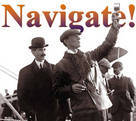
 Up
Up 
 Model R
Model R 
(You are here.)



  Need
to Need
to
find your
bearings?
Try
these
navigation aids:
If
this is your first
visit, please stop by:
Something
to share?
Please:



|
|
Available in Française, Español, Português, Deutsch, Россию,
中文,
日本, and others.
 lso
called the "Roadster" and the "Baby Wright", the
Wrights built this small one-place biplane especially for their British
friend Alec Ogilvie. He flew it in the Gordon Bennett air race at Belmont Park, NY, in October 1910,
coming in third with an average speed of 55 mph (89 kph). After the
race, Ogilvie shipped the Model R to England where he continued to
fly it in air meets. lso
called the "Roadster" and the "Baby Wright", the
Wrights built this small one-place biplane especially for their British
friend Alec Ogilvie. He flew it in the Gordon Bennett air race at Belmont Park, NY, in October 1910,
coming in third with an average speed of 55 mph (89 kph). After the
race, Ogilvie shipped the Model R to England where he continued to
fly it in air meets.
The Wright Fliers (the Wright exhibition
team) brought their own Model R to the 1910 Gordon Bennett air
race, an even
smaller version with a V-8 engine called the "Baby Grand." Orville
test-flew this aircraft at more than 70 mph (113 kph) on 25 Oct 1910 and it was
favored to win the race. Unfortunately on 29 October, Wright
pilot Walter Brookins experienced an engine failure while flying the
aircraft. He crashed and the Model R was substantially damaged,
keeping it out of the competition. It was later rebuilt and Brookins
flew it for exhibition flights.
Wright Model R "Baby Wright" specifications:
- 26.5 ft (8 m) wingspan
- 3.5 ft (107 cm) chord
- 3.5 ft (107 cm) separation
- 185 sq ft (17.2 sq. m) wing area
- 1:20 camber
- 28
sq ft (2.6 sq m) estimated horizontal rear elevator
- 10.5 sq ft (1 sq m) twin movable vertical rear rudders
- 27 ft (8.2 m) overall length estimated
- Estimated 670 lbs (363 kg) total weight (without pilot)
- 4 cylinder engine, approximately 30 hp running at 1425 rpm
- Two contra-rotating propellers, 8.5 ft (259 cm) long, turning
at 450 rpm
- 55 mph (89 kph) average speed
Wright Model R "Baby Grand" specifications:
- 21 ft (6.4 m) wingspan
- 3.5 ft (107 cm) chord
- 3.5 ft (107 cm) separation
- 147 sq ft (13.7 sq. m) wing area
- 1:20 camber
- 28
sq ft (2.6 sq m) horizontal rear elevator
- 10.5 sq ft (1 sq m) twin movable vertical rear rudders
- 27 ft (8.2 m) overall length
- Estimated 790 lbs (363 kg) total weight (without pilot)
- 8 cylinder engine, over 50 hp running at 1600 rpm estimated
- Two contra-rotating propellers, 8.5 ft (259 cm) long, turning
at 500 rpm estimated
- 70 mph (113 kph) average speed
References:
- McFarland, Marvin W. (ed), "The papers of Wilbur and Orville
Wright." McGraw-Hill Book Co., New York, 1953, pp 1199,
1216-1217, plates 210 and 229.
- Hobbs, Leonard S., "The Wright Brothers' Engines and Their
Design." Washington, D.C.: Smithsonian Institution Press, 1971,
pp 47-48.
- Lippincott, Harvey H., "Propulsion System of the Wright
Brothers." In Wolko, Howard S. (editor), "The Wright Flyer,
an Engineering Perspective." The Smithsonian Institution Press,
1987, p 89.
[Submitted by Joe W. McDaniel] |
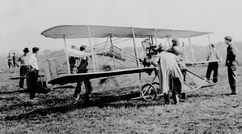
Alec Ogilvie preps the engine of his brand new Wright Model R at the
Wright flying field near Dayton, Ohio.
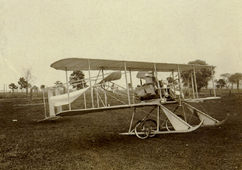
The Wright Model R "Baby Grand" with short wings and a V-8 engine.
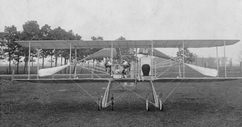
A front view of the Baby Grand. To reduce drag, the Wright arranged
the pilot, gas tank, and radiator in a line, one behind the other.
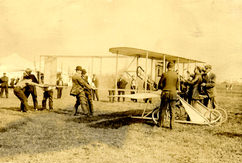
Orville adjusts the engine of the Baby Grand while Wilbur the the
Wright Fliers hold it down.
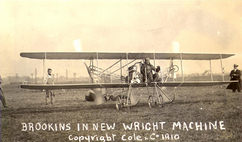
After it crashed in Belmont, the Baby Grand was rebuilt with longer
wings and a four-cylinder motor, like Alec Olgivie's Model R. This
airplane would later evolve into the Wright
Model EX.
|
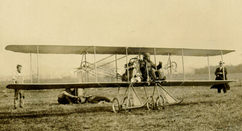
Alec Ogilvie ready to launch his Model R. Ogilvie also invented the
first practical airspeed indicator.
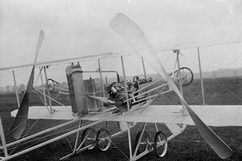
Close-up of the engine and drive train of the Baby Grand.
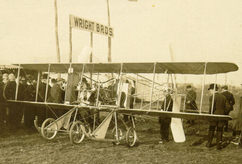
The Wright Model R "Baby Grand" on display at the Gordon Bennett Air
Races in Belmont, NY October 1910. Note that the Wrights have added
a set of wheels near the front ends of the skids.
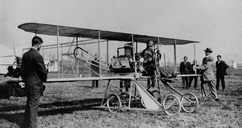
Orville in the pilot's seat, preparing to launch the Baby Grand. The
short wings and excess power made the aircraft very difficult to
fly.
|